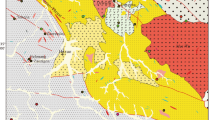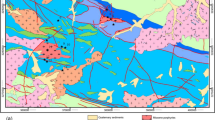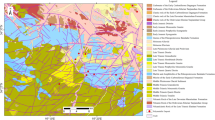Abstract
Supervised data-driven mineral prospectivity mapping (MPM) usually employs both positive and negative training datasets. Positive training datasets are typically created using the locations of known mineral deposits, whereas negative training datasets can be generated using the locations of random points. However, not all the negative points can be treated as true negative samples, which means that the selection of random negative training points creates uncertainty. This study provides a framework for addressing the effects of random negative training points on MPM. Fifty negative training datasets were generated using random point locations, and 50 mineral potential maps were created using logistic regression model. The area under the receiver operating characteristic curves (AUC) was used to evaluate the MPM performance. The mean of the AUC was employed to represent the average spatial correlation between mineralization and the selected spatial patterns, and the standard deviation of the AUC was used to indicate uncertainty relating to the use of random negative training samples. Additionally, a risk and return analysis was conducted to explore the uncertainty of the mineral potential map due to the use of random negative samples, and an odds ratio of probability was employed to describe the chances of both the occurrence and non-occurrence of a mineral deposit. The risk and return maps were obtained using the average and standard deviation of the log odds ratio per location. The mean of the log odds ratio was transformed into a mean probability, which can be regarded as the final mineral potential value that considers uncertainty due to random negative samples. Initial mineral exploration can thus be prioritized in areas that have low risk and high return compared to other areas. The proposed framework was demonstrated by mapping potential for skarn Fe mineralization in southwestern Fujian, China.

modified from Zuo et al. 2015)












Similar content being viewed by others
References
Agterberg, F. P., & Bonham-Carter, G. F. (1999). Logistic regression and weights of evidence modeling in mineral exploration. In 28th international symposium on applications of computer in the mineral industry (APCOM) (pp. 483–490), Golden, Colorado.
Bonham-Carter, G. F. (1994). Geographic information systems for geoscientists: Modelling with GIS (p. 398). Ontario: Pergamon.
Bonham–Carter, G. F., Agterberg, F. P., & Wright, D. F. (1989). Weights-of-evidence modelling: a new approach to mapping mineral potential. In: F. P. Agterberg, G. F. Bonham-Carter (Eds.), Statistical applications in the earth sciences (pp. 89–9, 171–183). Geological Survey of Canada.
Brown, W. M., Gedeon, T. D., Groves, D. I., & Barnes, R. G. (2000). Artificial neural networks: A new method for mineral prospectivity mapping. Australian Journal of Earth Sciences, 47, 757–770.
Carranza, E. J. M., & Hale, M. (2003). Evidential belief functions for data–driven geologically constrained mapping of gold potential, Baguio district, Philippines. Ore Geology Reviews, 22, 117–132.
Carranza, E. J. M. (2008). Geochemical anomaly and mineral prospectivity mapping in GIS. In: Handbook of exploration and environmental geochemistry (Vol. 11, p. 351). Elsevier: Amsterdam.
Carranza, E. J. M., Hale, M., & Faassen, C. (2008). Selection of coherent deposit-type locations and their application in data-driven mineral prospectivity mapping. Ore Geology Reviews, 33, 536–558.
Chen, Y., & Wu, W. (2017). Mapping mineral prospectivity using an extreme learning machine regression. Ore Geology Reviews, 80, 200–213.
Cheng, Q. (2007). Mapping singularities with stream sediment geochemical data for prediction of undiscovered mineral deposits in Gejiu, Yunnan Province, China. Ore Geology Reviews, 32, 314–324.
Cheng, Q. (2015). BoostWofE: A new sequential weights of evidence model reducing the effect of conditional dependency. Mathematical Geosciences, 47, 591–621.
Cheng, Q., & Agterberg, F. P. (1999). Fuzzy weights of evidence method and its application in mineral potential mapping. Natural Resources Research, 8, 27–35.
Cheng, Q., Xu, Y., & Grunsky, E. (2000). Integrated spatial and spectrum method for geochemical anomaly separation. Nature Resources Research, 9, 43–52.
Fawcett, T. (2006). An introduction to ROC analysis. Pattern Recognition Letters, 27, 861–874.
Gao, Y., Zhang, Z., Xiong, Y., & Zuo, R. (2016). Mapping mineral prospectivity for Cu polymetallic mineralization in southwest Fujian Province, China. Ore Geology Reviews, 75, 16–28.
Ge, C., Han, F., Zhou, T., & Chen, D. (1981). Geological characteristics of the Mafikeng iron deposit of marine volcano-sedimentary origin. Acta Geosicientia Sinica, 3, 47–69. (In Chinese with English abstract).
Han, F., & Ge, C. (1983). Geological and geochemical features of submarine volcanic hydrothermal-sedimentary mineralization of Makeng iron deposit, Fujian Province. Acta Geosicientia Sinica, 7, 1–118. (In Chinese with English abstract).
Nykänen, V., Lahti, I., Niiranen, T., & Korhonen, K. (2015). Receiver operating characteristics (ROC) as validation tool for prospectivity models—a magmatic Ni–Cu case study from the Central Lapland Greenstone Belt, northern Finland. Ore Geology Reviews, 71, 853–860.
Nykänen, V. (2008). Radial basis functional link nets used as a prospectivity mapping tool for orogenic gold deposits within the Central Lapland Greenstone Belt, Northern Fennoscandian Shield. Natural Resources Research, 17, 29–48.
Porwal, A., Carranza, E. J. M., & Hale, M. (2006). Bayesian network classifiers for mineral potential mapping. Computers and Geosciences, 32, 1–16.
Rodriguez-Galiano, V., Sanchez-Castillo, M., Chica-Olmo, M., & Chica-Rivas, M. (2015). Machine learning predictive models for mineral prospectivity: An evaluation of neural networks, random forest, regression trees and support vector machines. Ore Geology Reviews, 71, 804–818.
Wang, Z., Yin, Z., Caers, J., & Zuo, R. (2020). A Monte Carlo-based framework for risk-return analysis in mineral prospectivity mapping. Geoscience Frontiers. https://doi.org/10.1016/j.gsf.2020.02.010.
Xie, X., Mu, X., & Ren, T. (1997). Geochemical mapping in China. Journal of Geochemical Exploration, 60, 99–113.
Xiong, Y., & Zuo, R. (2018). GIS-based rare events logistic regression for mineral prospectivity mapping. Computers and Geosciences, 111, 18–25.
Zhang, Z., & Zuo, R. (2014). Sr–Nd–Pb isotope systematics of magnetite: Implications for the genesis of Makeng Fe deposit, southern China. Ore Geology Reviews, 57, 53–60.
Zhang, Z., & Zuo, R. (2015). Tectonic evolution of southwestern Fujian Province and spatial-temporal distribution regularity of mineral deposits. Acta Petrologica Sinica, 31, 217–229. (In Chinese with English abstract).
Zhang, Z., Zuo, R., & Cheng, Q. (2015a). The mineralization age of the Makeng Fe deposit, South China: Implications from U-Pb and Sm–Nd geochronology. International Journal of Earth Sciences, 104, 663–682.
Zhang, Z., Zuo, R., & Cheng, Q. (2015b). Geological features and formation processes of the Makeng Fe deposit, China. Resource Geology, 65, 266–284.
Zhang, Z., Zuo, R., & Xiong, Y. (2016). A comparative study of fuzzy weights of evidence and random forests for mapping mineral prospectivity for skarn-type Fe deposits in the southwestern Fujian metallogenic belt, China. Science China Earth Sciences, 59, 556–572.
Zuo, R. (2018). Selection of an elemental association related to mineralization using spatial analysis. Journal of Geochemical Exploration, 184, 150–157.
Zuo, R., & Carranza, E. M. J. (2011). Support vector machine: a tool for mapping mineral prospectivity. Computers & Geosciences, 37, 1967–1975.
Zuo, R., & Wang, J. (2020). ArcFractal: An ArcGIS add–in for processing geoscience data using fractal/multifractal models. Natural Resources Research, 29, 3–12.
Zuo, R., Cheng, Q., & Agterberg, F. P. (2009). Application of a hybrid method combining multilevel fuzzy comprehensive evaluation with asymmetric fuzzy relation analysis to mapping prospectivity. Ore Geology Reviews, 35, 101–108.
Zuo, R., Zhang, Z., Zhang, D., Carranza, E. J. M., & Wang, H. (2015). Evaluation of uncertainty in mineral prospectivity mapping due to missing evidence: a case study with skarn-type Fe deposits in Southwestern Fujin Province, China. Ore Geology Reviews, 71, 502–515.
Acknowledgments
We would thank two reviewers’ and Mahyar Yousefi’s comments and suggestions, which helped us improve this study. This study was supported by the National Natural Science Foundation of China (No. 41772344), and the MOST Special Fund from the State Key Laboratory of Geological Processes and Mineral Resources, China University of Geosciences (MSFGPMR03-3).
Author information
Authors and Affiliations
Corresponding author
Rights and permissions
About this article
Cite this article
Zuo, R., Wang, Z. Effects of Random Negative Training Samples on Mineral Prospectivity Mapping. Nat Resour Res 29, 3443–3455 (2020). https://doi.org/10.1007/s11053-020-09668-6
Received:
Accepted:
Published:
Issue Date:
DOI: https://doi.org/10.1007/s11053-020-09668-6




